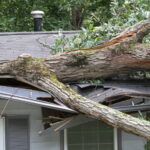Many people assume mold is only a problem during warm, humid months. But the truth is, mold can grow just as easily in the winter, especially inside homes that stay warm and sealed up against the cold. Understanding why mold appears during the winter and how to prevent it can protect your home from costly repairs and health risks.
Why Mold Can Grow in Cold Weather
Mold doesn’t need heat to grow; it needs moisture and organic materials to feed on. In the winter, homes are often tightly sealed to keep warm air inside, which can trap humidity. When that moisture collects on cold surfaces like windows, walls, or ceilings, mold spores can settle and begin to grow.
Condensation is one of the biggest causes of winter mold. It happens when warm indoor air meets a cold surface, like a window or uninsulated wall. This trapped moisture becomes the perfect environment for mold colonies to form.
Common Areas Where Winter Mold Appears
Some areas of a home are more prone to mold during the winter months. Windowsills, basements, and bathrooms are common problem spots because they often hold excess moisture. Attics are also at risk, especially if poor ventilation traps warm, moist air that rises from below.
If your home has experienced water damage from leaks or melting ice, hidden mold could already be growing behind walls or under flooring. Even small drips from a roof leak or plumbing issue can create conditions for mold to spread quickly.
How to Prevent Winter Mold Growth
The best way to stop mold from taking hold is to control indoor humidity and airflow. Keep humidity levels between 30% and 50% using a dehumidifier if needed. Make sure exhaust fans in kitchens and bathrooms are working properly and venting air to the outside.
Insulate cold surfaces like pipes, windows, and exterior walls to reduce condensation. Regularly check for leaks in your roof, around windows, and near plumbing fixtures. When snow or ice builds up around your home, make sure water from melting snow drains away from your foundation instead of seeping into the basement.
What to Do If You Find Mold
If you notice mold growing on surfaces, clean small patches right away using a mix of water and mild detergent. Avoid using bleach on porous materials like drywall or wood, as it can damage surfaces and won’t reach hidden mold roots.
For larger infestations or recurring mold problems, call a professional restoration company to assess the damage. They can safely remove mold, dry affected areas, and check for hidden moisture that could lead to future growth.
Why Professional Mold Removal Is Important
Even small mold problems can spread quickly if not handled correctly. Professionals use specialized tools to find hidden moisture and remove mold completely, ensuring it doesn’t return. They also take precautions to prevent spores from spreading to other parts of your home during cleanup.
“Mold often surprises homeowners in the winter because they don’t expect it during cold weather,” says David Rogers, owner of Service Pro Restoration. “But once moisture gets trapped indoors, it only takes a few days for mold to start growing. A professional inspection can save you from a much bigger issue later.”
Keep Your Home Dry and Safe This Winter
Winter mold might not be as visible as summertime growth, but it’s just as damaging. By keeping your home dry, improving ventilation, and addressing leaks early, you can stop mold before it spreads. Regular maintenance and quick action are the best ways to keep your home healthy and protected through the cold months.










